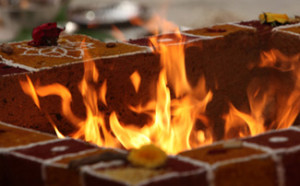 It is very important for the Vedic mantras to be chanted with the proper intonations that are referred to as “Swaras”. Another basic criterion is that the Vedas ought to be learnt from a learned Guru (Teacher) who passes the knowledge to the Shishya (Disciple). This is a tradition that is prevalent from the start of civilization. This is essentially imbibed in the teachings of the Vedas that gives utmost importance to the teacher – “Acharya Devo Bhava” that is translated as “The teacher is a form of God”.
It is very important for the Vedic mantras to be chanted with the proper intonations that are referred to as “Swaras”. Another basic criterion is that the Vedas ought to be learnt from a learned Guru (Teacher) who passes the knowledge to the Shishya (Disciple). This is a tradition that is prevalent from the start of civilization. This is essentially imbibed in the teachings of the Vedas that gives utmost importance to the teacher – “Acharya Devo Bhava” that is translated as “The teacher is a form of God”.
Recitation of the Vedic mantras regularly has multifold benefits. It improves the concentration, brings positive energy and bestows mental and spiritual strength to the reciter. It is scientifically proven that the chanting of the Vedic mantras regulates the
breathing (prana) and has the effect of pranayama and also has the power to heal. Along with the intonations the reciter needs to be conscious of the essence of the Vedas i.e. to relate the self to the Supreme Being or the Param Atma who is the source of the creation and exists in all forms in this material universe and also permeates beyond the material existence and is formless.
This consciousness of the reciter once firmly rooted in the thought process results in the purification of one’s thoughts. This brings more clarity in the thoughts and brings about a sense of contentment. The self is now tuned to realize the Supreme Being and the thought process is now aligned with the universal creator.
The experience of the reciter of the Vedic mantras is divine and prolonged chanting of the mantras gives the reciter a balanced outlook towards life and leads to eternal bliss. Homas or Havans is a ritual performed as per Vedic traditions that invokes the Supreme Lord for benefits in this material world. The process involves lighting the sacred fire (Agni Deva who is mentioned as Jataveda in the Sri Suktam of Rig Veda). The sacred fire, Agni is the link between the material world and the spiritual world. As part of this process Vedic mantras are chanted by learned priests. The sacred fire is the medium of carrying these mantras to the Supreme Being. The various offerings made to the sacred fire reach the Supreme Being and this results in the fulfillment of one’s wishes.
The offerings made to the sacred fire are sticks made out of branches of the peepal tree (ficus religiosa or sacred fig), ghee, ashta dravya (eight items – rice flakes, dried coconuts, molasses, sesame oil, sugarcane, banana, lemon, jaggery), rice etc.
